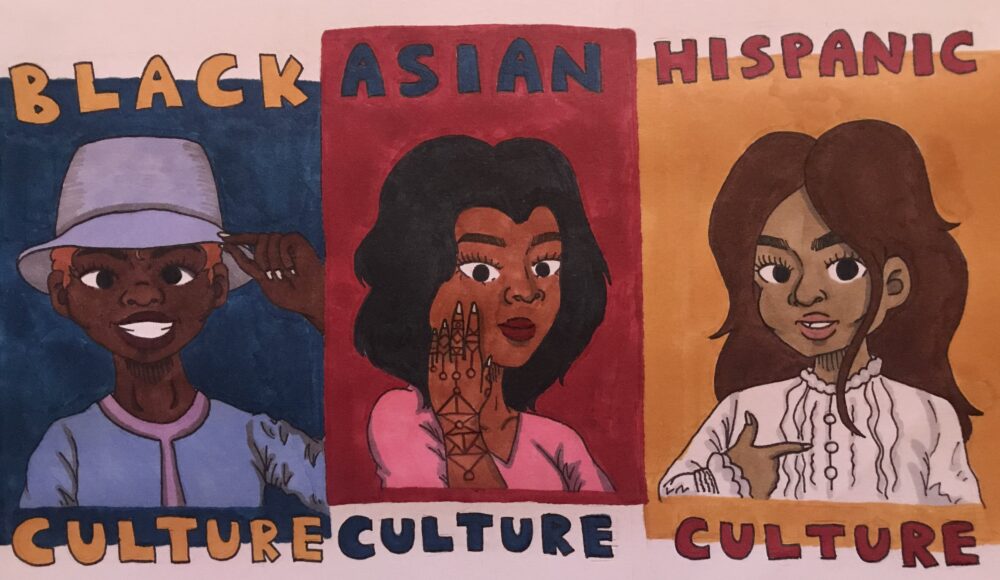
By Jessica Nguyen
It’s no secret that fashion trends come and go throughout the seasons. In an age of modern technology and social media, it’s even easier to blend together different styles from around the world. So, how many of your favorite fashion trends came from other cultures?
Black culture
A quick swipe through your TikTok “for you page” leads you to see a beautiful girl with colorful stripes in her hair, an oversized t-shirt, wide-legged jeans and Jordan’s topped off with a bucket hat. Styles like this are now considered popular and trendy but before they became one of Generation Z’s staple outfits, they were a part of Black culture.
Bucket hats have been seen on the heads of many celebrities, influencers and fishermen! The bucket hat was invented to protect fishermen from the rain and was later adopted by the military in the ‘40s. After being seen worn by LL Cool J and Rihanna, the bucket hat has become regarded as a wardrobe ‘must-have’ and an easy way to spice up your outfit.
Oversized clothing has also become popular in the past months whether it be baggy jeans or large graphic t-shirts. They offer an effortlessly chic look, especially while staying at home. The oversized trend gained popularity during the hip-hop era back in the ‘80s.
People from the Black community, including many families, wore oversized clothing. Their clothes were often second-hand from other family members to save money. Many hip-hop artists and rappers wear oversized clothing and have made it a big hit among teens.
Since the invention of rubbers, sneakers have been around but didn’t gain popularity until the ‘70s when Nike was founded. Although they were first reserved for sports such as basketball, sneakers became popular after rappers began wearing them. Now a symbol of status and money, sneakers like Jordans cost an average of $145, and you can easily find any teen wearing Air Force 1s.
Hoop earrings date back to the first civilization Sumer and are associated with African beauty, but have now become a favorite fashion accessory thanks to Black and Latino culture.
Scripted necklaces are also another fashion ‘must-have’. Its roots come from New York City neighborhoods, where kids wore them as a way to show their individuality and their ‘hard to pronounce’ names. Scripted necklaces were also a way to prove that kids were responsible for their own metal jewelry.
Asian culture
Kimonos originated from Japan as a symbol of class dynamics and are seen as elegant, beautiful pieces of cultural wear. Although once associated with a traditional garment worn on special occasions, they are now light cover-ups that are often worn during the spring and summertime.
Many places, from Malaysia to Morocco, have henna tattoos, so it is hard to pinpoint its origin, but countless Middle Eastern, African and Asian cultures have used henna as a prenuptial ritual for brides to make them look extravagant for their wedding day. Henna tattoo stations are now popular at many fairs and festivals.
Many teens and millennials also sport nose rings, but before they were hot accessories for alt Tiktokers, nose rings were religious and cultural symbols in different cultures, including Indian and South African.
In India, nose rings are believed to reduce menstrual pain and increase fertility. Along with henna, brides in India wear nose rings during their weddings. Nose rings are also worn to honor the Hindu goddess of marriage Parvathi; however, in South Africa, nose rings are a symbol of wealth in Beja and Berber tribes.
Other cultures
Pencil or liquid eyeliner was once regarded as something to fight off evil spirits and eye disease. It was believed to be magical, having to do the ancient gods Horus and Ra, who would protect the people from illnesses. The American Chemical Society has reported that eyeliner has nitric oxide, which revs up the immune system; many scientists believed that Egyptians used this lead-based cosmetic as makeup for this reason.
And when we think of cowboys, we think of the Old West, cowboy hats, vests and boots, which came from Spain in the 1100s. They dated back to cattle herders who wore hats, jackets, tight-fitting trousers and boots. Cowboy outfits later became associated with cowboys when the cattle industry expanded to the northern plains of the Americas in the 1880s since leather provided protection from the cold.
In light of the Black Lives Matter movement, it is important to recognize how other cultures have diversified and changed our society. These fashion trends are now regarded as essential pieces of teen fashion but they have been taken away from other cultures to be reclaimed as “appropriate” and “popular,” revealing a double standard between white and people of color.
Fashion trends from other cultures also bring up discussions about cultural appropriation and appreciation. Appreciation is when you honor and respect another culture and its practices and give credit to the culture, while appropriation is when you only pick certain aspects of a culture to exploit and ignore its significance from that culture. There’s a fine line between them and it is important to know the difference as you explore different fashion styles.
So, as you wear a bucket hat and eyeliner, remember their origin stories and how important other cultures are in your daily life.





